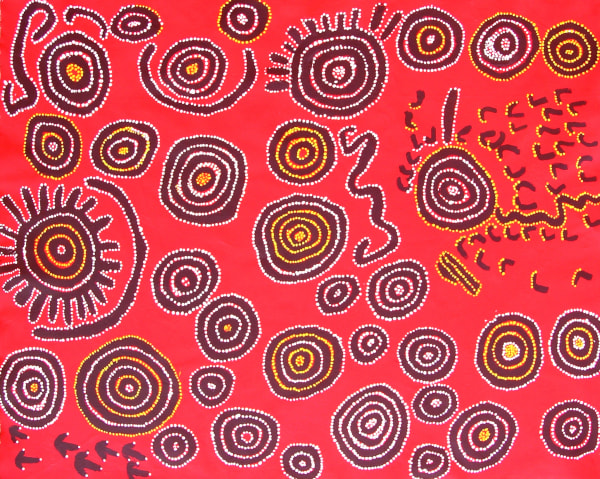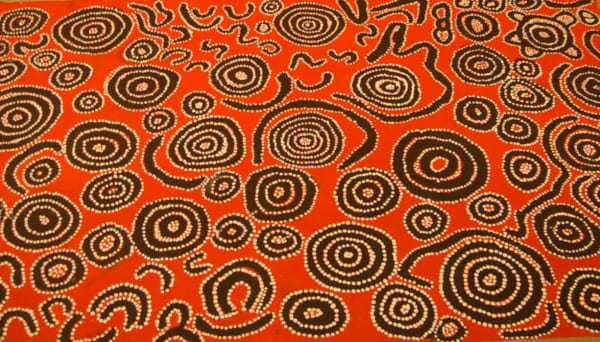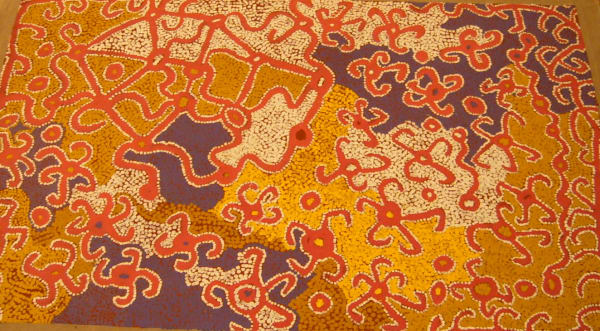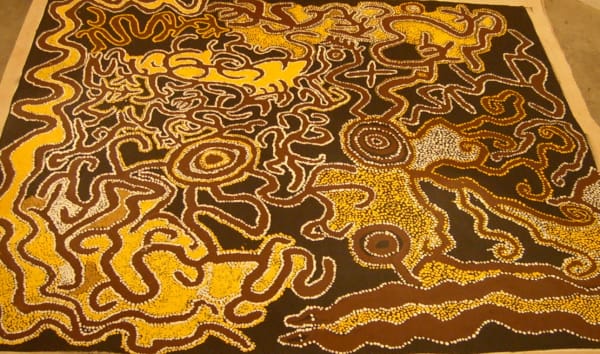Ilkurlka: The Art of the Spinifex People: Group Show
The Spinifex People say ‘Kapi ninti’, which translates roughly as, ‘We know the water’. And in their harsh desert environment, knowing where the water holes are is essential to life. Such knowledge, to a large extent, forms the basis of the aboriginal concept of ownership - or custodianship - of the land. Demonstrating a profound knowledge of the many- and often hidden- waterholes across their ‘country’ was the foundation of the Spinifex People’s successful claim to native title.
For the Spinifex People, as for all aboriginal desert-dwellers, water holes are sacred sites. Many of their traditional stories – the Dreamings or Tjukurppa – recount how the waterholes were created, where they are and when they can be visited. Knowledge of these stories is preserved and passed on from generation to generation - through ritual. It is also recorded in painting. Amongst the most important waterholes in Spinifex Country is the rockhole at Ilkurlka, some three hundred and fifty kilometers north-east of the principal settlement of Tjuntjuntjara. It is a small hole, about six foot deep, with – when I visited it in January 2005 – only a damp patch at the bottom to suggest the water hiding deeper down. All around – as far as the eye can see – stretch miles of scrub covered dunes of reddish sand. The sky is too bright to look at, the sun unrelenting.
The Ilkurlka rockhole is a particularly important site in two major Spinifex Dreamings – the Wati Jutjara (or Two Men) Story, and the Kalaya (or Emu) Story.
In paintings detailing these Dreamings the waterhole can appear, either as a central element, or a mere part of an intricate scheme. The aerial perspective and circumscribed iconography of Spinifex art means that the waterhole itself is most often rendered as a simple circle. Nevertheless, despite the strong cartographic flavor of all aboriginal desert art, elements of the surrounding landscape – the trees and grasses, the rolling sandhills – can be, and often are, represented or alluded to. The coloring, too, of the paintings, though anti-naturalistic, is frequently significant. - Rebecca Hossack
-
 Cyril Brown, Untitled
Cyril Brown, Untitled -
 Cyril Brown, Ngarparla, 2005
Cyril Brown, Ngarparla, 2005 -
 Cyril Brown, Kulyuru
Cyril Brown, Kulyuru -
 Cyril Brown, Untitled
Cyril Brown, Untitled -
 Bill Anderson, Irl Billi , 2005
Bill Anderson, Irl Billi , 2005 -
 Byron Brookes, Untitled
Byron Brookes, Untitled -
 Estelle Hogan, Nyir Panta , 2005
Estelle Hogan, Nyir Panta , 2005 -
 Lorraine Davis, Untitled , 2005
Lorraine Davis, Untitled , 2005 -
 Mark Anderson, Baltjuu, 2005
Mark Anderson, Baltjuu, 2005 -
 Mark Anderson, Pirapii, 2005
Mark Anderson, Pirapii, 2005 -
 Roy Underwood, Dirdii, 2004
Roy Underwood, Dirdii, 2004 -
 Roy Underwood, Ilkurlka, 2005
Roy Underwood, Ilkurlka, 2005 -
 Simon Hogan, Ilkurlka, 2005
Simon Hogan, Ilkurlka, 2005 -
 Ned Grant, Kurpuruu
Ned Grant, Kurpuruu -
 Ned Grant, Untitled
Ned Grant, Untitled -
 Walter Hansen, Tjutaja, 2005
Walter Hansen, Tjutaja, 2005 -
 Walter Hansen, Tjutatjaa, 2005
Walter Hansen, Tjutatjaa, 2005 -
 Nulbinga Simms, Wayu, 2005
Nulbinga Simms, Wayu, 2005 -
 Lennard Walker, Tjukurltjara, 2005
Lennard Walker, Tjukurltjara, 2005 -
 Fred Grant, Ukadatjara, 2005
Fred Grant, Ukadatjara, 2005





















